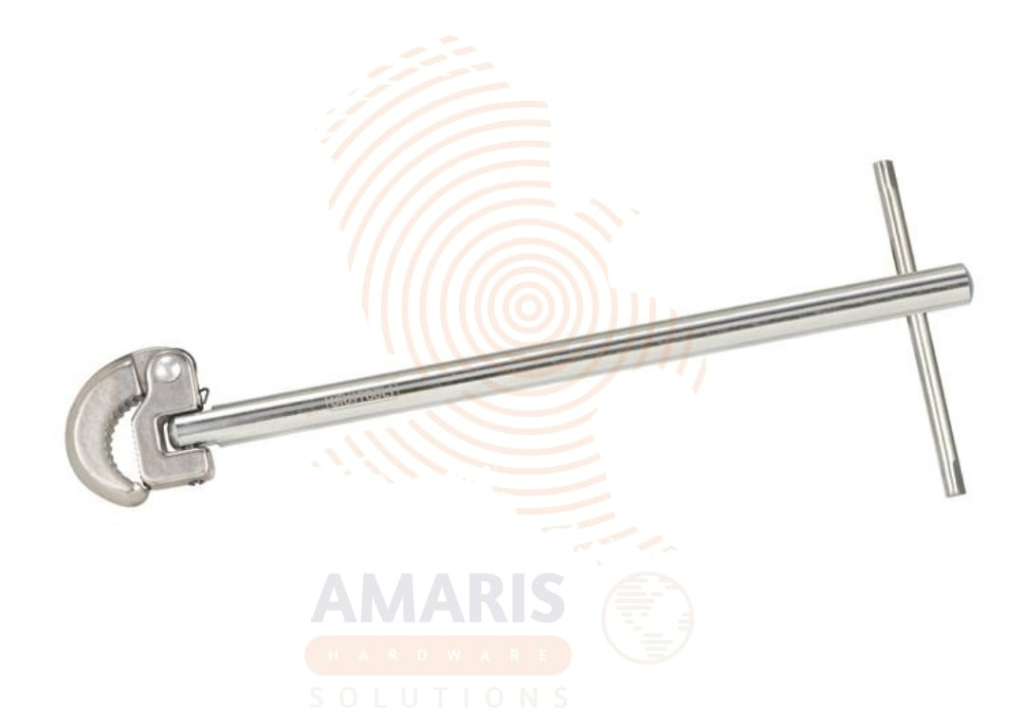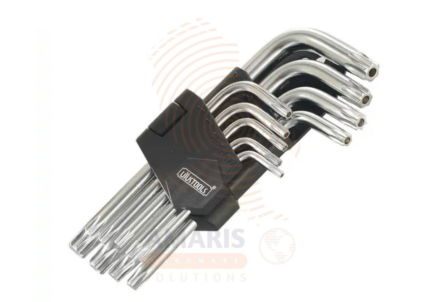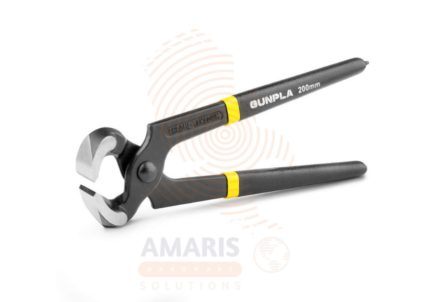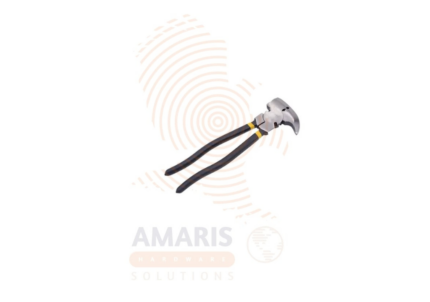Back to products
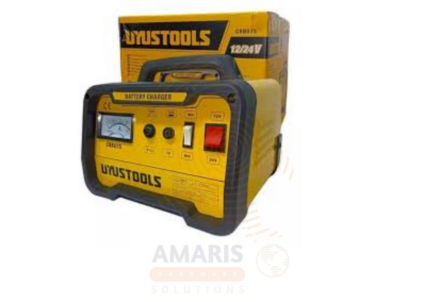

12 And 24V Battery Charger
$75.00 Original price was: $75.00.$71.25Current price is: $71.25.
Basin Wrench with Fixable Head
WhatsApp Order
A Basin Wrench with Fixable Head is a specialized plumbing tool designed for the installation and removal of nuts in confined spaces, particularly in and around basins and sinks. The tool features an adjustable and fixable head, allowing the user to set it at different angles for versatile use in tight quarters. The wrench typically has a long handle and a pivoting jaw with a spring-loaded mechanism, enabling it to grip and turn nuts located in hard-to-reach areas. The fixable head feature ensures stability and ease of use, making it a valuable tool for plumbing tasks in areas with limited access.
Description
Table of Contents
ToggleBasin Wrench with Fixable Head
Uses
-
Faucet Installation and Removal: Basin wrenches are frequently employed for installing and removing faucets in kitchen and bathroom sinks. The fixable head allows for different angles, making it easier to access and tighten or loosen nuts in confined spaces.
-
Sink and Basin Nut Tightening: The tool is designed to reach and tighten nuts located on the underside of sinks and basins. This is crucial for securing the sink to the countertop or for fastening other plumbing connections.
-
Supply Line Connection: Basin wrenches are useful for connecting and disconnecting water supply lines to faucets or other plumbing fixtures. The adjustable head enables plumbers to reach awkwardly positioned nuts with ease.
-
Drain Assembly Work: Plumbers often use basin wrenches when working on drain assemblies beneath sinks. The tool allows for the tightening or loosening of nuts securing the drain components.
-
Strainer Installation: When installing or replacing sink strainers, a basin wrench is valuable for reaching and securing the mounting nuts. The fixable head ensures stability during the tightening process.
-
Pipe Fitting in Tight Spaces: In confined areas, especially under sinks, the basin wrench with a fixable head is instrumental for tightening or loosening pipe fittings, making it easier to perform repairs or replacements.
-
Adjustable Angles for Versatility: The ability to fix the head at different angles is particularly helpful when dealing with complex plumbing configurations, allowing the user to adapt the tool to various tight spaces and angles.
-
Limited Access Areas: Basin wrenches are designed to navigate tight and hard-to-reach spaces, making them essential for plumbing tasks where standard wrenches or pliers may not fit.
SAFETY HANDLING PRECAUTIONS
Safety Precautions
-
Personal Protective Equipment (PPE):
-
Always wear appropriate personal protective equipment, including safety glasses or goggles to protect your eyes from debris or splashing water.
-
-
Stability and Balance:
-
Ensure stable footing when using the basin wrench. Be aware of your surroundings, and position yourself in a way that maintains balance to avoid slipping or falling.
-
-
Inspect the Tool:
-
Before use, inspect the basin wrench for any damage or defects. Ensure that the fixable head is secure and functioning properly. Do not use a damaged tool.
-
-
Secure the Work Area:
-
Clear the work area of any obstacles or tripping hazards. Make sure the sink or basin is stable and properly supported.
-
-
Turn Off Water Supply:
-
Before starting any plumbing work, turn off the water supply to the fixture you're working on. This helps prevent accidental water discharge during the task.
-
-
Secure Loose Clothing:
-
Avoid wearing loose clothing or jewelry that could get caught in the wrench or other plumbing components.
-
-
Proper Technique:
-
Use the basin wrench according to the manufacturer's instructions. Apply force in a controlled manner, and do not overexert yourself. Use both hands on the wrench for better control.
-
-
Adjustable Head Position:
-
Adjust the head of the basin wrench to the required angle before starting the task. Ensure it is securely fixed in place to prevent unexpected movement during use.
-
-
Be Mindful of Sharp Edges:
-
Some plumbing components may have sharp edges. Be cautious when reaching into tight spaces to avoid cuts or abrasions.
-
-
Work with Adequate Lighting:
-
Ensure proper lighting in the work area to clearly see what you are doing. This helps prevent mistakes and reduces the risk of injury.
-
-
Follow Plumbing Codes and Regulations:
-
Adhere to local plumbing codes and regulations. Improper installations or repairs can lead to safety hazards.
-
-
Emergency Preparedness:
-
Familiarize yourself with the location of emergency shut-off valves and equipment in case of unexpected issues.
-
-
Know Your Limits:
-
-
If a task appears beyond your skill level or requires specialized knowledge, seek professional help. Don't hesitate to contact a plumber for complex plumbing issues.
-
Related products
Ball Point Hex Wrench Set – Medium
A Ball Point Hex Wrench Set - Medium size typically refers to a collection of nine hexagonal (hex) wrenches designed with ballpoint ends. The term "medium" may refer to the size or thickness of the wrenches, indicating that they are neither too small nor too large. The ballpoint end allows for a more flexible angle of approach when using the wrench, making it easier to engage with hexagonal screws or bolts at various angles. This set is likely to include different sizes to accommodate a range of applications, providing versatility for tasks that require hexagonal tools of medium dimensions.
Bodywork Tool Set
A Bodywork Tool Set typically refers to a collection of seven specialized tools designed for use in automotive body repair and restoration. These tools are specifically crafted to assist in shaping, smoothing, and repairing the body panels of vehicles, addressing issues such as dents, dings, and other imperfections. The set may include various tools such as hammers, dollies, and other shaping implements, each serving a specific purpose in the process of restoring or enhancing the appearance of a vehicle's bodywork. These tool sets are commonly used by auto body technicians, mechanics, or individuals involved in automotive restoration projects.
Carpenter’s Pincers
Carpenter's pincers, also known as end-cutting pliers or end nippers, are a type of hand tool used in carpentry and woodworking. They typically have sharp, pointed jaws that come together in a cutting edge at the tips. These pincers are designed for gripping, cutting, and pulling materials such as nails, wires, or small objects in woodworking applications. The jaws are angled to provide leverage and facilitate precise cutting or gripping in tight spaces. Carpenter's pincers are a versatile tool commonly found in a carpenter's toolkit for various tasks related to shaping and assembling wood.
Carving chisel set
A carving chisel set typically refers to a collection of twelve individual chisels specifically designed for carving and shaping wood or other materials. These sets often include a variety of chisel shapes and sizes, such as straight gouges, bent gouges, V-parting tools, and skew chisels. Each chisel in the set serves a unique purpose, allowing artisans and woodworkers to achieve different carving techniques and create intricate details in their projects. The set is designed to provide a comprehensive selection of tools that cater to various carving needs, offering versatility and precision in woodworking and carving applications.
Die Set
An "8 PCS DIE SET" typically refers to an 8-piece die set used in various manufacturing and machining processes. In manufacturing and metalworking, dies are specialized tools used to shape, cut, or form materials such as metal, plastic, or other substances. A die set, in this context, is a collection of individual dies designed to work together for specific tasks.
Fence Pliers
Fence pliers are a specialized type of pliers designed for use in fencing and related tasks. They typically feature a combination of functions that make them well-suited for various activities involved in installing, repairing, and maintaining fences. These pliers often include features such as a gripping jaw, wire-cutting blades, a staple puller, and sometimes a hammerhead. The design of fence pliers aims to provide versatility and convenience for professionals or DIY enthusiasts working with fencing materials, wires, and staples.
Flat Hand Steel File
PRODUCT DESCRIPTION
A flat hand file is a type of hand tool used in metalworking and woodworking to remove material from a workpiece by abrasion. It consists of a flat, elongated piece of metal with parallel rows of teeth or ridges, called the file's "cut," which are designed to cut or shape a material when rubbed against it. Flat hand files are typically rectangular in shape and come in various sizes and coarseness grades, allowing for different levels of material removal and finishing. These files are commonly used for smoothing, shaping, and leveling surfaces in a variety of applications, providing a versatile means of material removal in manual craftsmanship.
Flat Steel File
PRODUCT DESCRIPTION
A flat steel file is a hand tool used for shaping, smoothing, and removing material from a workpiece, typically made of steel. It consists of a flat, elongated piece of metal with a series of parallel teeth or ridges along one or both of its surfaces. These teeth are designed to cut or abrade material when the file is pushed or pulled across a surface. Flat steel files are commonly used in metalworking, woodworking, and other crafts to achieve precise and smooth finishes on various materials.


 Acrylic Sealants
Acrylic Sealants Construction Adhesives
Construction Adhesives Double-Sided Tape
Double-Sided Tape Duct Tape
Duct Tape Electrical Tape
Electrical Tape Epoxy & Resins
Epoxy & Resins Masking Tape
Masking Tape
 Automotive Wrenches & Socket Sets
Automotive Wrenches & Socket Sets Battery Chargers & Jump Starters
Battery Chargers & Jump Starters Car Jacks & Stands
Car Jacks & Stands Car Wash & Detailing Products
Car Wash & Detailing Products Diagnostic Tools
Diagnostic Tools Tire Inflators
Tire Inflators Vehicle Lighting
Vehicle Lighting Oil & Lubricants
Oil & Lubricants
 Adhesives & Sealants
Adhesives & Sealants Bricks & Blocks
Bricks & Blocks Cement & Concrete
Cement & Concrete Drywall & Plaster
Drywall & Plaster Flooring (Tiles, Wood, Laminate)
Flooring (Tiles, Wood, Laminate) Lumber & Plywood
Lumber & Plywood Paints, Primers & Coatings
Paints, Primers & Coatings Insulation Materials
Insulation Materials Roofing Materials
Roofing Materials
 Circuit Breakers
Circuit Breakers Electrical Cables & Wires
Electrical Cables & Wires Switches & Sockets
Switches & Sockets Fuses & Relays
Fuses & Relays Connectors & Terminals
Connectors & Terminals Electrical Boxes & Panels
Electrical Boxes & Panels Conduit & Fittings
Conduit & Fittings Lighting Fixtures & Bulbs
Lighting Fixtures & Bulbs Extension Cords & Power Strips
Extension Cords & Power Strips
 Anchors
Anchors Bolts
Bolts Clips & Clamps
Clips & Clamps Screws
Screws Nuts
Nuts Washers
Washers Rivets
Rivets Nails
Nails Threaded Rods
Threaded Rods
 Hammers
Hammers Measuring Tools (Tapes, Levels, Calipers)
Measuring Tools (Tapes, Levels, Calipers) Screwdrivers
Screwdrivers Pliers & Cutters
Pliers & Cutters Saws & Blades
Saws & Blades Chisels & Punches
Chisels & Punches Allen Keys & Hex Keys
Allen Keys & Hex Keys Ratchets & Socket Sets
Ratchets & Socket Sets Wrenches & Spanners
Wrenches & Spanners
 Power Tool Accessories (Blades, Bits, Discs)
Power Tool Accessories (Blades, Bits, Discs) Rotary Tools
Rotary Tools Saws (Circular, Jigsaw, Reciprocating)
Saws (Circular, Jigsaw, Reciprocating) Drills & Drivers
Drills & Drivers Grinders & Sanders
Grinders & Sanders Heat Guns
Heat Guns Nail Guns
Nail Guns Impact Wrenches
Impact Wrenches Batteries & Chargers
Batteries & Chargers
 Pipes & Fittings (PVC, Copper, PEX)
Pipes & Fittings (PVC, Copper, PEX) Plumbing Tools
Plumbing Tools Pumps & Motors
Pumps & Motors Sealants & Adhesives for Plumbing
Sealants & Adhesives for Plumbing Valves & Taps
Valves & Taps Water Heaters
Water Heaters Drainage Systems
Drainage Systems Faucets & Fixtures
Faucets & Fixtures Hoses & Tubing
Hoses & Tubing
 Hinges & Latches
Hinges & Latches Hooks & Brackets
Hooks & Brackets Window Hardware
Window Hardware Chains & Cables
Chains & Cables Casters & Wheels
Casters & Wheels Shelving & Storage Systems
Shelving & Storage Systems Door Handles & Locks
Door Handles & Locks Drawer Slides & Cabinet Hardware
Drawer Slides & Cabinet Hardware
 Personal Protective Equipment (PPE)
Personal Protective Equipment (PPE) Respirators & Masks
Respirators & Masks Safety Glasses
Safety Glasses Safes
Safes Security Cameras
Security Cameras Gloves
Gloves Helmets
Helmets Ear Protection
Ear Protection Fire Safety Equipment
Fire Safety Equipment Locks & Padlocks
Locks & Padlocks Motion Sensors & Alarms
Motion Sensors & Alarms
 Garden Fencing
Garden Fencing Garden Furniture Hardware
Garden Furniture Hardware Lawn Mowers
Lawn Mowers Trimmers & Edgers
Trimmers & Edgers Shovels & Spades
Shovels & Spades Rakes & Hoes
Rakes & Hoes Pruning Shears & Loppers
Pruning Shears & Loppers Watering Systems (Hoses, Sprinklers, Nozzles)
Watering Systems (Hoses, Sprinklers, Nozzles)
 Interior Paints
Interior Paints Paint Brushes & Rollers
Paint Brushes & Rollers Paint Strippers & Thinners
Paint Strippers & Thinners Paint Trays & Accessories
Paint Trays & Accessories Exterior Paints
Exterior Paints Spray Paints
Spray Paints Primers & Undercoats
Primers & Undercoats Varnishes & Stains
Varnishes & Stains
 Gaskets & Seals
Gaskets & Seals Hydraulic Fittings
Hydraulic Fittings Industrial Fasteners
Industrial Fasteners Industrial Hoses
Industrial Hoses Lubricants & Greases
Lubricants & Greases Metal Sheets & Bars
Metal Sheets & Bars Bearings & Bushings
Bearings & Bushings Belts & Pulleys
Belts & Pulleys
 HVAC Filters
HVAC Filters Insulation for HVAC
Insulation for HVAC Air Conditioners
Air Conditioners Refrigerants
Refrigerants Ventilation Ducts & Fittings
Ventilation Ducts & Fittings Thermostats & Controllers
Thermostats & Controllers Fans & Blowers
Fans & Blowers
 Pegboards & Hooks
Pegboards & Hooks Shelving Units
Shelving Units Storage Bins & Containers
Storage Bins & Containers Toolboxes & Tool Chests
Toolboxes & Tool Chests Workbenches
Workbenches Drawer Organizers
Drawer Organizers Labeling Supplies
Labeling Supplies
 Welding Accessories (Clamps, Brushes)
Welding Accessories (Clamps, Brushes) Welding Electrodes & Rods
Welding Electrodes & Rods Welding Helmets & Gloves
Welding Helmets & Gloves Welding Machines
Welding Machines Soldering Irons & Stations
Soldering Irons & Stations Flux & Solder Wire
Flux & Solder Wire
 Generator Accessories
Generator Accessories Inverters
Inverters Portable Generators
Portable Generators Power Inverters
Power Inverters Transfer Switches
Transfer Switches Diesel & Gasoline Generators
Diesel & Gasoline Generators
 Transport Equipment: Carts, Dollies, and Hand Trucks
Transport Equipment: Carts, Dollies, and Hand Trucks Storage Solutions: Pallets, Racks, and Containers
Storage Solutions: Pallets, Racks, and Containers Lifting Equipment: Hoists, Cranes, and Jacks
Lifting Equipment: Hoists, Cranes, and Jacks Conveyors and Accessories: Belts and Rollers
Conveyors and Accessories: Belts and Rollers